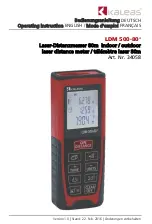
6
TB-BA-e-1713
The sensor 3-1 has to be placed carefully onto the base plate. The Zero-key 3-3 has
to be pressed and “0” will be displayed, without lifting the sensor from the base plate.
Annotation: Zero calibration is not valid, if the sensor does not contact the cal-
ibration plate directly or any other uncoated base material.
6.2 An appropriate calibration foil has to be chosen according to the typical meas-
urement range.
6.3 This one has to be put onto the base plate or another uncoated base material.
Note: The sensor has to be located min. 3mm distant from the edge of the base
plate.
6.4 The sensor 3-1 has to be placed carefully onto the calibration foil and then it has
to be lifted. Now the result is displayed. This can be corrected by pressing the Plus-
key 3-4 or the Minus- key 3-5. For doing this, the sensor must be removed from the
base plate or the material to be measured.
6.5 Step 6.4 has to be repeated, until the measurement accuracy is achieved.
7 Batteriewechsel
7.1 If the battery symbol „+/-“appears on the display of if the battery voltage is less
than 4.8V, batteries should be replaced.
7.2 For this, battery cover 3-8 has to be removed and batteries must be taken off.
7.3 Batteries (4x1,5V AA) have to be installed correctly into the case.
7.4 If the instrument is not in use for an extended period, batteries have to be taken
out.
Wird das Gerät für einen längeren Zeitraum nicht benutzt, sollten die Batterien ent-
nommen werden.
8 Adjustment foils
This instrument has included in delivery a set of adjustment foils with different foils
and thicknesses, whereupon the measurement range of 20 up to 2000µm will always
be covered. These adjustment foils are also available as an optional accessory, arti-
cle number ATB-US07.
9 Correct handling at coating thickness measurement with exter-
nal sensors
The sensor has to be touched at the lower shaft (pole) segment and it has to be
pressed slightly onto the test object.
Sensor (orange=F, black=N)
Spring shaft for handling
Sensor tip

























